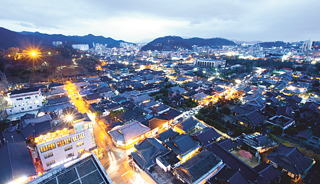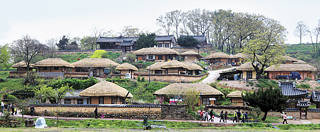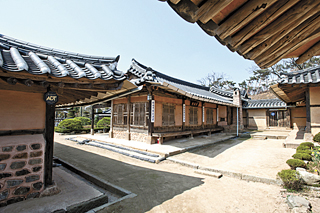A one-night visit to a traditional Joseon-era home: The once-abandoned hanok is a renovated and modern getaway

Top: The Arumjigi Hamyang Hanok consists of five structures. Although staying in a hanok can be a cold, inconvenient experience, the Arumjigi Hamyang Hanok had a comfortable ondol system and modern bathrooms built in all of the structures. Left: Food is one of the biggest delights of the Arumjigi Hamyang Hanok. The kitchen and the dining room are in a structure that has two glass walls, allowing meals with a view. Right: The bamboo forest in the back seen from the window of the master’s quarters. [PARK WOO-JIN, KIM HYUNG-EUN]
HAMYANG, South Gyeongsang - Being fascinated by an old, abandoned house is not totally absurd, it’s probably safe to say.
Questions like “who lived here?” and “what kind of things happened here?” often come to mind when people browse through the dust-filled corners of an old house.
The hanok (traditional Korean housing) in Hamyang, South Gyeongsang, is also a house with a story to tell - having been the setting of both high points and low points for its occupants.
Built in 1866, the house was the home of the Jeongseon Jeon clan, who were the in-laws of Jeong Yeo-chang (1450-1504), the renowned Confucian scholar from Korea’s Joseon Dynasty (1392-1910).
The house witnessed the Jeongseon Jeon clan prosper for decades. But as is often the case in Korea, the children got good education and landed respectable jobs in the cities, often the capital.
As a result, the house was unattended and eventually went abandoned for years.
The village the house is located in, Bongjeon Village, known for the scenic Hwalim Valley nearby, also lost its former glory, as young people moved away.
But this all changed once the descendants donated the house to the Arumjigi Culture Keepers Foundation, a nonprofit foundation tasked with preserving and promoting the aesthetics of traditional Korean culture, particularly in clothing, food or housing.
The foundation renovated the house, and since 2006, it has been open for overnight stays as well as other irregular cultural programs like photo exhibitions.
Inviting and convenient
Arriving in Hamyang after a three-hour bus ride from Seoul, I felt somewhat sad to see this village - which used to be the home of the greatest thinkers and scholars of Joseon - so quiet and aged. It felt like time has stopped here and I felt like the youngest person in the village.
Passing by a closed elementary school and several abandoned houses, I arrived at the Arumjigi Hamyang Hanok. As is the case with most old houses of a prosperous family in Korea, the house had good placement, with a mountain in the back and water in the front.
Lee Jae-cheol, who used to be a carpenter but now works at Arumjigi as the “keeper” of the hanok, greeted me and led me to the room where I would be staying. My guest and I were to stay in the “master’s quarters” which had two rooms with traditional Korean ondol heating and a bathroom.
So the Arumjigi Hamyang Hanok isn’t the traditional Korean house, as a in a traditional house a bathroom would be in a separate structure.
“Most old hanok where people can stay overnight have changed traditional heating [systems] into modern ones and ancient toilets into contemporary ones,” Kim Bong-ryol, an architect and president of the Korea National University of Arts, says, “But Arumjigi’s idea was different.”
While maintaining its original structure, Arumjigi built bathrooms in each of the structures of the complex, to make it as convenient as possible for those staying here, Kim added. He advised Arumjigi for the restoration project.
As is the case with hanok, having a remarkable view in the front and the back was the charm of the “master’s quarters.” In the back, there was a bamboo forest and when you keep the windows open, you have a view and can breathe the fresh air that you rarely experience in the city.
Good food, craftwork
Tasting traditional Korean food is often one of the reasons why people go to hanok lodgings.
Food is one of the biggest strengths of the Arumjigi Hamyang Hanok.
When the food was ready, a bell rang to let the guests know. The food was prepared in another structure, a former storage facility. This structure has been renovated as a kitchen and dining room and has glass walls offering a mealtime with a view.
Lee cooks for the guests, and he is quite the chef.
“Arumjigi officials visited homes of this region and conducted research on what local people eat and how they cook,” he said. One of the main dishes of the two-day stay, steamed pumpkin in soy bean paste sauce (one of my favorites), was in fact, what many old ladies in the village ate.
One cannot help but notice the beautiful ceramic pieces used to serve the food. In fact, enjoying craftwork, traditional home decor items and furniture pieces was another joy of staying Arumjigi Hamyang Hanok.
Ranging from a pleat-patterned ceramic bowl and a long, lean royal blue candle to traditional paintings of nature and wooden furniture pieces of various shapes, the house was filled with unique items.
The small wooden chairs which line the front yard of the master’s quarters are from the closed elementary school nearby.
Relaxing bath (but sleepless night)
One of the structures of the Arumjigi Hamyang Hanok, which also used to be a storage facility, has been renovated into a bath and shower facility that can accommodate several people. Like a public bathhouse, there are separate facilities for men and women.
One of the most interesting features of Arumjigi Hamyang Hanok has to be this structure. It’s made of ocher brick and its roof is made of Eulalia thatch. There are several hanok with thatch, but none with Eulalia thatch.
Every two years, they have to replace the Eulalia thatch with newly cut ones, which is such hard work, according to Lee, that it lasts for about a month. “The elders who know the [roofmaking] technique are passing [away] one after another,” he added.
In fact, the house is extremely high maintenance. The bamboo forest in the back also requires a lot of work. Lee and other workers have to tend it regularly, as bamboo grows quickly.
As there is no digital entertainment here, bedtime came early. My guest and I were worried as we couldn’t lock our room as we traditionally would in hotels.
Lee, however, assured us that there is a security system that would detect intruders. Lee is also just a holler away, residing right next door with his family. Even with the assurance, my guest and I couldn’t sleep for a long time, which perhaps is the downside of most hanok lodgings. On the bright side, however, my company and I stayed up all night chatting.
Although our visit took place on a chilly day, the ondol system was reliable. The floor was heated to where we felt like we were in jjimjilbang (public bath facility). Lee said Arumjigi invested a lot in the ondol system to make sure guests can stay warm even during the coldest nights.
All in all, my experience in Arumjigi Hamyang Hanok was very satisfying. As the inner quarters are also available, a larger group’s overnight stay is an option. For more information, visit www.arumjigihamyang.org or call Arumjigi at 02-741-8373.
Peek into the past while staying in Korea’s beautiful hanok villages

[JOONGANG ILBO]
Jeonju, North Jeolla
Jeonju Hanok Village in Jeonju, North Jeolla is one of the most popular hanok villages in Korea. Although many have criticized how it’s lately turned into more of an entertainment facility, still it’s highly favored especially by youngsters and foreigners. Several houses within the village offer an over-night stay program, but there isn’t a website where one can get the information for all of them. Visitors should also know that lodging in the village may not be in a hanok built centuries ago. The village has many eateries as well as craft and art studios. http://tour.jeonju.go.kr / 063-282-1330

[JOONGANG ILBO]
Gyeongju, North Gyeongsang
If you want to spend a night in a more isolated, quiet environment, the Yangdong Village in the historic city of Gyeongju is a great option. The village is home to some 480 traditional Korean houses dating back to the early Joseon Dynasty (1392-1910). The village was named a state-designated cultural heritage site in 1984. About a 30-minute drive from Singyeongju Station, the village has streams, farms and even outdoor markets. Several houses offer lodging and prices differ by the house. The hanok lodgings here are usually original hanoks from the Joseon Dynasty.
www.yangdongvillage.com / 054-762-2630

[JOONGANG ILBO]
Seosan, South Chungcheong
Gyeam Gotaek (Old House) in Seosan, South Chungcheong was chosen by the Korea Tourism Organization as one of the best hanok lodgings in Korea in 2014.
The house, built in the mid-19th century, got high scores for offering various cultural programs for guests like making traditional roof tiles and learning to recite traditional poetry.
Seosan has several historic sites worth a visit like the Rock-carved Buddha Triad in Yonghyeon-ri (National Treasure No. 84.)
http://gyeamgotaek.modoo.at / 010-2376-8273, 010-2376-8273

[JOONGANG ILBO]
Andong, North Gyeongsang
The hanok resort in the historic city of Andong consists of seven hanok structures. They include the one built by Lee Hui-myeon (1807-58), a descendent of Yi Hwang (1501-70), the renowned scholar and government official of the Joseon Dynasty; as well as another one built by Yi Ji (1560-1631), also a high-ranking government official of Joseon. Due to the construction of a dam in Andong, several important hanok structures were in danger of flooding. As a result, the city as well as SK group worked together to relocate them.
www.gurume-andong.com / 054-823-9001
BY KIM HYUNG-EUN [hkim@joongang.co.kr]










with the Korea JoongAng Daily
To write comments, please log in to one of the accounts.
Standards Board Policy (0/250자)